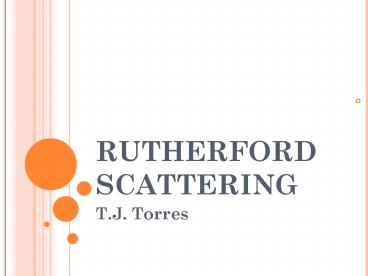RUTHERFORD SCATTERING PowerPoint PPT Presentation
1 / 14
Title: RUTHERFORD SCATTERING
1
RUTHERFORD SCATTERING
- T.J. Torres
2
OUTLINE
- Introduction
- Motivation
- Rutherford versus Plum-pudding Model
- Experiment and Setup
- Alpha Beam Characteristics
- Data and Analysis
- Error Analysis
- Results and Conclusion
3
INTRODUCTION
- There was much confusion amongst physicists about
the structure of the atom during the early
twentieth century. - Plum-pudding model proposed in1897 after electron
discovery. - Experimental evidence in 1909 conflicted with the
Plum-pudding model. - Ernest Rutherford predicts different atomic
structure with a massive center of positive
charge. - The two models are conflicting.
4
MOTIVATION
- Experimental Purpose
- To compare results from alpha particle scattering
off Au foil to the predicted theoretical results
from both the Rutherford and Plum-pudding models
of the atom. - Importance
- If the comparison of our data to one of the
models is strong enough, we can make with
reasonable certainty claims about how the atom is
structured, advancing human understanding of
matter and the world around us.
5
RUTHERFORD AND PLUM-PUDDING MODELS OF THE ATOM
- Plum-pudding
- Rutherford
- Electrons were free to move in a cloud of
positive charge. - Little explanation about atomic mass.
- Allowed for electron movement and bound states.
- Electrons reside outside a heavy center of
positive charge. - Mass of atom resides predominantly within the
nucleus. - Allowed for electron movement in orbits, but gave
no structure to bound states.
6
RUTHERFORD AND PLUM-PUDDING MODELS OF THE ATOM
(THEORETICAL PREDICTIONS)
- Plum-pudding
- Rutherford
- Fractional Scattering Distribution
- Where is the mean multiple scattering
which we shall take to be 1 degree.
- Fractional Scattering Distribution
7
EXPERIMENT
- Alpha particle howitzer fixed to Au foil.
- Both are rotated relative to the detector, and
counting results are recorded on MCA. - Apparatus contained in vacuum to reduce energy
loss from air
8
ALPHA BEAM CHARACTERISTICS
Beam width and maximum obtained by taking count
measurements at 10 degrees to either direction of
proposed center.
9
DATA (PLUM PUDDING FITTING)
- Deviance at even 10 degrees outside the beam
center is far too large to obtain a reasonable
fitting with Matlab. Thus under the most generous
circumstances there model does not agree with our
data.
10
DATA (RUTHERFORD FITTING)
- Data presents good correlation with the
Rutherford model and all residuals are reasonably
close to the fit line with the exception of one
point which can be attributed to error.
11
(No Transcript)
12
COMPARISON TO THEORETICAL RESULT
- Recall that
- We use the same functional model for fitting, so
we need only compare the theoretical and
experimental values of multiplied by the
initial count rate.
13
ERROR ANALYSIS
- Possible Contributors to error
- Noticed oddly shaped pulses during certain data
gathering periods that suggest false count number
due to loose wiring. - Run time allotment only allowed for limited
statistical accuracy. - Multiple Scattering.
- Foil thickness error due to incomplete vacuum.
- Noise from improper detector bias/discriminator
settings
14
RESULTS AND CONCLUSIONS
- Recall that for the Plum-Pudding model our data
had a correlation . - Similarly, for the Rutherford model
- We conclude from this with reasonable certainty
that our data agrees strongly with the Rutherford
model and not at all for the angles of interest
with the Plum-pudding model. - The agreement between experimental and
theoretical calculation had an error of around
44, which suggests that the model still holds
true for the atom if allowances for error are
taken into account. - One concludes that the atom is comprised of a
massive nucleus with positive charge.

